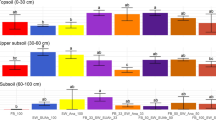Abstract
This paper presents estimates of yield for effort of the cultivar, ‘Taputini,’ which is sweet potato that was eaten by the Māori of New Zealand before European contact in the 18th century. The two experimental archaeology gardens were planted at sites on either side of Cook Strait: the one with clay soils is on the South Island at Robin Hood Bay; the one with sandy soils is at Whatarangi on the North Island. The records of labor input required to cultivate these gardens over seven years for Robin Hood Bay and six years for Whatarangi compared with crop yields provide data on the economics of pre-European kũmara gardening. Also reported are some of the properties of the soil. These gardens produced an average of 12 metric tons (1,000 kilograms=1 metric ton) per hectare (ha), which is not much less than contemporary yields for modern cultivars and 3 to 4 times most previous estimates of pre-European production.
Similar content being viewed by others
Literature Cited
Beaglehole, J. C., ed. 1963. The Edeavour Journal of Joseph Banks 1769–1771. Trustees of the Public Library of New South Wales, Sydney, Australia.
Best, E. 1976. Maori Agriculture A. R. Shearer. Government Printer, Wellington, New Zealand.
Brougham, A. E., and Reed A. W. 1975. Lilliput Maori Proverbs. A. H. & A. W. Reed, Wellington, New Zealand.
Bourke, R. M. 1985. Sweet Potato (Ipomoea batatus) Production and Research in Papua New Guinea. Papua New Guinea Journal of Agriculture, Forestry and Fisheries 33:89–108.
Burtenshaw, M., G. Harris, J. Davidson and F. Leach. 2003. Experimental Growing of Pre-European Cultivars of Kũmara (Sweet Potato, Ipomoea batatus [L.] Lam.) at the Southern Margins of Mãori Horticulture. New Zealand Journal of Archaeology 23 (2001):161–188.
Challis, A. J. 1991. The Nelson-Marlborough Region: An Archaeological Synthesis. New Zealand Journal of Archaeology 13:101–142.
Colenso, W. 1880. On the Vegetable Foods of the Ancient New Zealanders before Cook’s Visit. Transactions and Proceedings of the New Zealand Institute 13:3–89.
Coleman, B. P. 1978. Kumara Growing. New Zealand Department of Agriculture Bulletin 294. Government Printer, Wellington, New Zeland.
Erickson, C. L. 1994. Methodological Considerations in the Study of Ancient Andean Field Systems. Pages 111–152 in N. F. Miller and K. L. Gleason, eds., The Archaeology of Garden and Field. University of Pennsylvania Press, Philadelphia, Pensylvania.
FAO. 2005. The FAOSTAT Agriculture Database. The Food and Agriculture Organization of the United Nations, Rome, Italy.
Green, R. C. 2005. Sweet Potato Transfers in Polynesian Prehistory. Pages 43–62 in C. Ballard, P. Brown, R. M. Bourke, and T. Harwood, eds., The Sweet Potato in Oceania: A Reappraisal. The University of Sydney, Sydney, Australia.
Haami, B., and M. Roberts. 2004. Genealogy as Taxonomy. International Social Science Journal 173: 402–412.
Harris, G. F. 2001. Conservation of Relict Potato Solanum tuberosum Cultivars within Maori Communities in New Zealand. Pacific Conservation Biology 7(3): 204–213.
Harvey, C. F., G. P. Gill, C. Crossman, and L. G. Fraser. 1997. Assessing Relationships of Kumara Cultivars by RAPD Analysis. New Zealand Journal of Botany 35:479–485.
Higham, T.F.G., and W. J. Gumbley, 2001. Early Preserved Polynesian Kumata Cultivations in New Zealand. Antiquity 75(289):511
Irwin, G. 1992. The Prehistoric Exploration and Colonization of the Pacific. Cambridge University Press, Cambridge, United Kingdom.
Jana, R. K. 1982. Status of Sweet Potato Cultivation in East Africa and Its Future. Pages 63–72 in R. L. Villareal and T. D. Griggs, eds., Sweet Potato. Proceedings of the First International Symposium. Asian Vegetable Research and Development Center (AVRDC), Shanhua, Tainan, Taiwan (Republic of China).
Jones, K. L. 1989. Traditional Maori Horticulture in Eastern North Island. New Zealand Agricultural Science 23:36–41.
—, and R. G. Law. 1987. Prehistoric Population Estimates for the Tolaga Bay Vicinity, East North Island, New Zealand. New Zealand Journal of Archaeology 9:81–144.
Leach, H. M. 1976. Horticulture in Prehistoric New Zealand: An Investigation of the Function of the Stone Walls of Palliser Bay. Otago University, Dunedin, New Zealand.
Orbell, M. 1985. The Natural World of the Maori. Collins, Auckland, New Zealand.
Reynolds, P. J. 1979. Iron Age Farm: The Butser Experiment. British Museum Publications Ltd., London.
Rigg, T., and J. A. Bruce. 1923 The Maori Garden Soils of Waimea West, Nelson, New Zealand. Journal of the Polynesian Society 32:85–93.
WAI 262. 1991. Treaty of Waitangi Claim brought against the New Zealand Crown by the members of the following six tribes (iwi): Ngãti Kuri, Ngãti Wai, Te Rarawa, Ngãti Porou, Ngãti Kahungunu, and Ngãti Koata). http://www.med.govt.nz/templates/Page — 1207. aspx (24 April 2007).
Walsh, Archdeacon. 1902. The Cultivation and Treatment of the Kumata by the Primitive Maori. Transactions of the New Zealand Institute 35:12–24.
Yen, D. E. 1961. The Adaptation of the Kumara by the New Zealand Maori. Journal of the Polynesian Society 70:338–348.
— 1961/62. The Potato of Early New Zealand. The Potato Journal 1:2–5.
— 1963. The New Zealand Kumara or Sweet Potato. Economic Botany 17:31–41.
— 1974. The Sweet Potato and Oceania: An Essay in Ethnobotany. Bishop Museum Bulletin 236. Honolulu, Hawai’i.
Author information
Authors and Affiliations
Corresponding author
Rights and permissions
About this article
Cite this article
Burtenshaw, M., Harris, G. Experimental archaeology gardens assessing the productivity of ancient Māori cultivars of sweet potato, Ipomoea batatas [L.] Lam. in New Zealand. Econ Bot 61, 235–245 (2007). https://doi.org/10.1663/0013-0001(2007)61[235:EAGATP]2.0.CO;2
Received:
Accepted:
Issue Date:
DOI: https://doi.org/10.1663/0013-0001(2007)61[235:EAGATP]2.0.CO;2




